Abstract
Dynamics of fluid feeding has been deeply studied in insects. However, the ability to vary the nectar-intake rate depending only on the carbohydrate deprivation has been clearly demonstrated only in Camponotus mus ants. When insect morphometry and fluid properties remain constant, changes in intake rate could only be attributed to variations in sucking pump activity. Previous records of the electrical activity generated during feeding in C. mus have revealed two different signal patterns: the regular (RP, frequencies: 2–5 Hz) and the irregular (IP, frequencies: 7–12 Hz). This work studies the mechanism underlying food intake-rate modulation in ants by analysing whether these patterns are involved. Behaviour and electrical activity generated by ants at different starvation levels were analysed during feeding on sucrose solutions. Ants were able to modulate the intake rate for a variety of sucrose concentrations (10, 40 and 60%w/w). The IP only occurred for 60% of solutions and its presence did not affect the intake rate. However, during the RP generated under the starved state, we found frequencies up to 7.5 Hz. RP frequencies positively correlated with the intake-rate for all sucrose concentrations. Hence, intake-rate modulation according to sugar deprivation is mainly achieved by the ant’s ability to vary the pumping frequency.




Similar content being viewed by others
Abbreviations
- F:
-
Predominant frequency
- IP:
-
Irregular pattern
- IP-prop:
-
Proportion of the irregular pattern in the signal
- IR:
-
Intake rate
- RIR:
-
Relative intake rate
- RP:
-
Regular pattern
References
Avery L, Horvitz HR (1990) Effects of starvation and neuroactive drugs on feeding in Caenorhabditis elegans. J Exp Zool 253(3):263–270
Baker (1975) Sugar concentrations in nectars from hummingbird flowers. Biotropica 7(1):37–41
Bennet-Clark HC (1963a) Negative pressures produced in the pharyngeal pump of the blood-sucking bug, Rhodnius prolixus. J Exp Biol 40:223–229
Bennet-Clark HC (1963b) The control of meal size in the blood sucking bug, Rhodnius prolixus. J Exp Biol 40:741–750
Blüthgen N, Gottsberger G, Fiedler K (2004) Sugar and amino acid composition of ant-attended nectar and honeydew sources from Australian rainforest. Austral Ecol 29:418–429
Borrell BJ (2006) Mechanics of nectar feeding in the orchid bee Euglossa imperialis: pressure, viscosity and flow. J Exp Biol 209:4901–4907
Borrell BJ (2007) Scaling of nectar foraging in orchid bees. Am Nat 169(5):569–580
Cosens D, Toussaint N (1986) The dynamic nature of the activities of the wood ant Formica aquilona foraging to static food resource within a laboratory habitat. Physiol Entomol 11:383–395
Davidson DW, Cook SC, Snelling RR (2004) Liquid-feeding performances of ants (Formicidae): ecological and evolutionary implications. Oecologia 139:255–266
Ferry-Graham LA, Wainwright PC, Westneat MW, Bellwood DR (2001) Modulation of prey capture kinematics in the cheeklined wrasse Oxycheilinus digrammus (Teleostei: Labridae). J Exp Zool 290(2):88–100
Grosclaude F, Núñez JA (1998) Foraging pauses and their meaning as an economic strategy in the honeybee Apis mellifera L. J Comp Physiol A 183:61–68
Guarneri AA, Diotaiuti L, Gontijo NF, Gontijo AF, Pereira MH (2000) Comparison of feeding behaviour of Triatoma infestans, Triatoma brasiliensis and Triatoma pseudomaculata in different host by electronic monitoring of the cibarial pump. J Insect Physiol 46:1121–1127
Guarneri AA, Diotaiuti L, Gontijo NF, Gontijo AF, Pereira MH (2003) Blood-feeding performance of nymphs and adults of Triatoma brasiliensis on human hosts. Acta Trop 87:361–370
Harder LD (1986) Effects of nectar concentration and flower depth on flower handling efficiency of bumble bees. Oecologia 69:309–315
Heyneman AJ (1983) Optimal sugar concentration of floral nectars-dependence on nectar energy flux and pollinator foraging cost. Oecologia 60:198–213
Hölldobler B, Wilson EO (1990) The ants. Harvard University Press, Cambridge
Horvitz HR, Chalfie M, Trent C, Sulston JE, Evans PD (1982) Serotonin and octopamine in the nematode Caenorhabditis elegans. Science 216(4549):1012–1014
Howard DF, Tschinkel WR (1980) The effect of colony size and starvation on food flow in the fire ant, Solenopsis invicta (Hymenoptera: Formicidae). Behav Ecol Sociobiol 7:293–300
Jaffé K, Sánchez C (1984) Comportamiento alimentario y sistema de reclutamiento en la hormiga Camponotus rufipes (Hymenoptera: Formicidae). Acta Cient Venezol 35:270–277
Josens RB (2002) Nectar feeding and body size in the ant Camponotus mus. Insectes Soc 49:326–330
Josens RB, Roces F (2000) Foraging in the ant Camponotus mus: nectar-intake rate and crop filling depend on colony starvation. J Insect Physiol 46(7):1103–1110
Josens RB, Farina WM (2001) Nectar feeding by the hovering hawk moth Macroglossum stellatarum: intake rate as a function of viscosity and concentration of sucrose solution. J Comp Physiol A 187:661–665
Josens RB, Farina WM, Roces F (1998) Nectar feeding by the ant Camponotus mus: intake rate and crop filling as a function of sucrose concentration. J Comp Physiol 44:579–585
Josens R, Falibene A, Figueiredo Gontijo A (2006) Electrical signals during sucking in the carpenter ant Camponotus mus. J Insects Physiol 52:1234–1242
Kingsolver JG, Daniel TL (1979) On the mechanics and energetics of nectar feeding in butterflies. J Theor Biol 76:167–179
Kingsolver JG, Daniel TL (1983) Mechanical determinants of nectar feeding strategy in hummingbirds: energetics, tongue morphology, and licking behavior. Oecologia 60:214–226
Kingsolver JG, Daniel TL (1993) Mechanics of fluid feeding in insects. In: Schaefer CW, Leschen RAB (ed) Functional morphology of insects feeding. Lanham, Maryland, pp 149–162
Mailleux AC, Detrain C, Deneubourg JL (2006) Starvation drives a threshold triggering communication. J Exp Biol 209:4224–4229
May PG (1985) Nectar uptake rates and optimal nectar concentrations of two butterfly species. Oecologia 66:381–386
McFarland D (1971) Control theory and behaviour theory. In: Feedback mechanisms in animal behaviour. Academic Press, London/New York
McGlynn TP, Kirksey SE (2000) The effects of food presentation and microhabitat upon resource monopoly in a ground-foraging ant (Hymenoptera: Formicidae) community. Rev Biol Trop 48:629–642
Medan V, Josens R (2005) Nectar foraging behaviour is affected by ant body size in Camponotus mus. J Insects Physiol 51:853–860
Nemeth DH (1997) Modulation of buccal pressure during prey capture in Hexagrammos decagrammus (Teleostei: Hexagrammidae). J Exp Biol 200(15):2145–2154
Niacaris T, Avery L (2003) Serotonin regulates repolarization of the C. elegans pharyngeal muscles. J Exp Biol 206:223–231
Novotny V, Wilson MR (1997) Why are the no small species among xylem-sucking insects? Evol Ecol 11:419–437
Núñez JA (1966) Quantitative Beziehngen zwischen den Eigenschaften von Futterquellen und dem Verhaltn von Sammelbienen. Z Vergl Physiol 53:142–164
Paul J, Roces F (2003) Fluid intake rates in ants correlate with their feeding habits. J Insects Physiol 49:347–357
Raizen DM, Lee RY, Avery L (1995) Interacting genes required for pharyngeal excitation by motor neuron MC in Caenorhabditis elegans. Genetics 141(4):1365–1382
Ribeiro JMC (1995) Blood-feeding arthropods: live syringes or invertebrate pharmacologists? Infect Agent Dis 4:143–152
Roces F, Núñez JA (1993) Information about food quality influences load-size selection in recruited leaf-cutting ants. Anim Behav 45:135–143
Roubik DW, Buchmann SL (1984) Nectar selection by Melipona y Apis mellifera (Hymenoptera: Apidae) and the ecology of nectar intake by bee colonies in a tropical forest. Oecologia 61:1–10
Sant’ Anna MRV, Diotaiuti L, Figueiredo Gontijo A, Figueiredo Gontijo N, Pereira MH (2001) Feeding behaviour of morphologically similar Rhodnius species: influence of mechanical characteristics and salivary function. J Insect Physiol 47:1459–1465
Sass GG, Motta PJ (2002) The effects of satiation on strike mode and prey capture kinematics in the largemouth bass, Micropterus salmoides. Env Biol Fish 65(4):441–454
Schilman PE, Roces F (2006) Foraging energetics of a nectar-feeding ant: metabolic expenditure as a function of food-source profitability. J Exp Biol 209:4091–4101
Smith JJB (1979) Effect of diet viscosity on the operation of the pharyngeal pump in the blood-feeding bug Rhodnius prolixus. J Exp Biol 82:93–104
Tatar M (1991) Clutch size in the swallowtail butterfly, Battus philenor: comparisons of behavior within and among seasonal flights in California. Behav Ecol Sociobiol 28:337–391
Thomson AJ, Holling CS (1974) Experimental component analysis of blowfly feeding behaviour. J Insect Physiol 20:1553–1563
Vogel S (2007) Living in a physical world. X. Pumping fluids through conduits. J Biosci 32(2):207–222
Wolf AV, Brown MG, Prentiss PF (1984) Concentrative properties of aqueous solutions: conversion tables. In: CRC handbook of chemistry and physics, 64th edn. CRC Press, Boca Raton, pp D223–D272
Acknowledgments
The authors thank Alberto F. Gontijo for his help on the electrical design and the recording programme. Authors also thank the two anonymous reviewers for comments that improved this manuscript. This study was partially supported by funds from the ANPCYT (PICT 2002-12310) and the Argentinean Research Council (CONICET- PIP 5986). The present work complies with the “Principles of animal care”, publication No. 86-23, revised 1985 of the National Institute of Health, and also with the current laws of the country in which the experiments were performed.
Author information
Authors and Affiliations
Corresponding author
Rights and permissions
About this article
Cite this article
Falibene, A., Josens, R. Nectar intake rate is modulated by changes in sucking pump activity according to colony starvation in carpenter ants. J Comp Physiol A 194, 491–500 (2008). https://doi.org/10.1007/s00359-008-0323-5
Received:
Revised:
Accepted:
Published:
Issue Date:
DOI: https://doi.org/10.1007/s00359-008-0323-5




